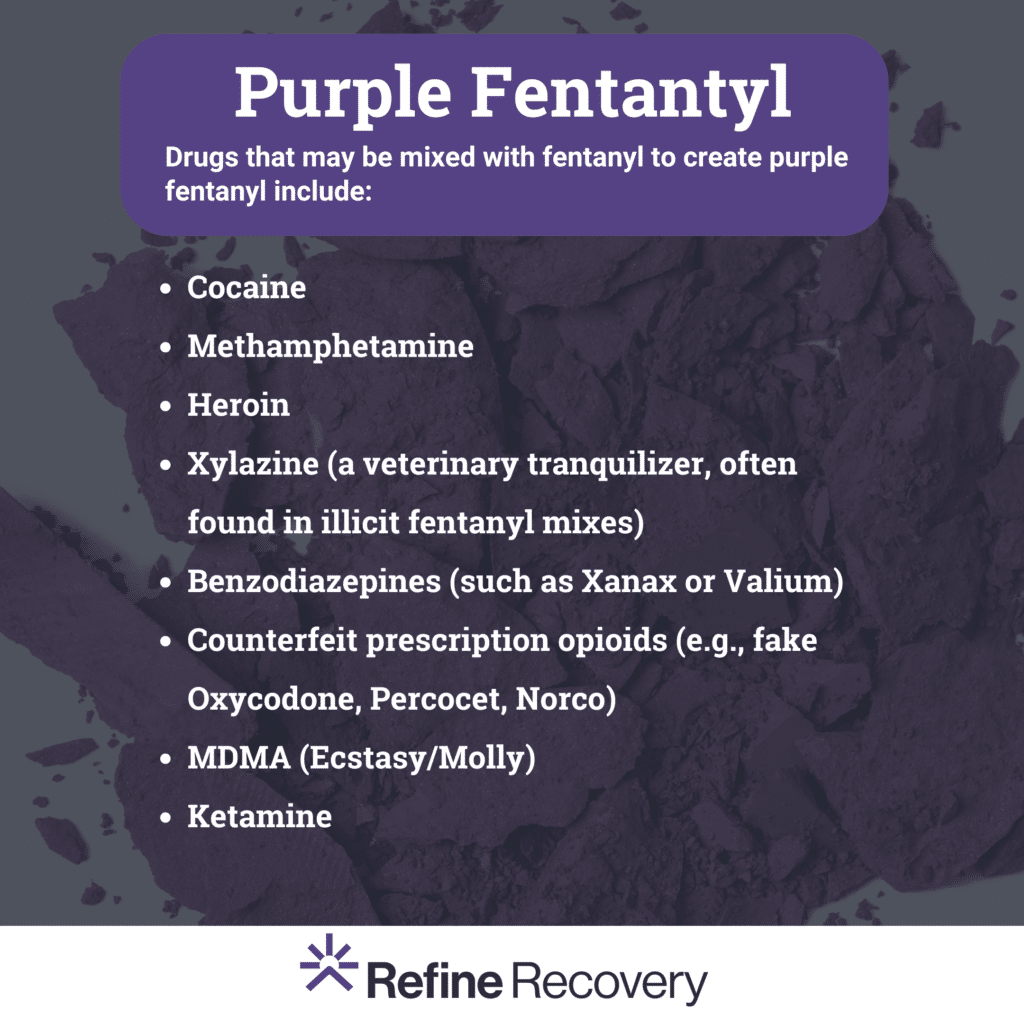Purple fentanyl, a colored form of the potent synthetic opioid fentanyl, has emerged as a significant threat in the ongoing drug overdose crisis. This substance is often mixed with other drugs, such as cocaine or methamphetamine, or sold as counterfeit pills, increasing the risk of unintentional overdose due to its extreme potency and unpredictable composition.
Fentanyl’s role in the opioid epidemic cannot be overstated. According to provisional data from the CDC’s National Center for Health Statistics, drug overdose deaths in the United States surged to an estimated 107,622 deaths in 2021, a nearly 15% increase from 2020. Overdose deaths involving synthetic opioids like fentanyl rose from 70,029 in 2020 to 80,816 in 2021, highlighting the growing danger of this class of drugs. Variants like purple fentanyl exacerbate the crisis by creating a false sense of safety or novelty among users, mainly when marketed deceptively.
Understanding the risks associated with purple fentanyl and potent opioids is critical for combating its impact. Its presence in counterfeit pills and mixed drug supplies underscores the importance of increased awareness, harm reduction strategies, and access to effective treatment programs. These efforts are essential to reducing the devastating toll of the opioid epidemic.
What Is Purple Fentanyl?
Purple fentanyl is a dyed variant of fentanyl, a synthetic opioid that is 50 times more potent than heroin and 100 times stronger than morphine. While the purple hue might seem like a branding attempt by manufacturers to appeal to specific users, its lethal risks remain unchanged. The DEA reports that fentanyl, including its colored forms, is primarily produced in clandestine labs controlled by Mexican cartels, which dominate the U.S. fentanyl supply chain.
In 2021 alone, fentanyl was involved in over 70,000 deaths in the United States, making it the leading cause of drug-related fatalities. The addition of dyes does nothing to mitigate the danger, as fentanyl is often mixed with other substances like cocaine or methamphetamine without users’ knowledge, further elevating the risk of accidental overdose.
Efforts to combat this crisis, such as DEA’s Operation Overdrive, aim to dismantle distribution networks funneling fentanyl and other drugs into communities. By understanding the threats posed by substances like purple fentanyl, individuals and policymakers can better address this growing public health issue.

The Dangers of Purple Fentanyl
Purple fentanyl carries all the inherent risks of standard fentanyl while introducing additional dangers due to its unregulated production and unpredictable potency. According to the National Institute on Drug Abuse (NIDA), synthetic opioids like fentanyl accounted for over 75,000 overdose deaths in 2022, representing nearly 80% of all opioid-related fatalities. This sharp rise underscores the increasing threat posed by substances like purple fentanyl, which are often sold illicitly and consumed without users understanding their potency.
High Potency
Purple fentanyl is exceptionally potent, with just two milligrams—about the size of a few grains of salt—being enough to cause a fatal overdose. How much fentanyl is lethal varies depending on individual tolerance, but even the smallest miscalculation can lead to deadly consequences. The extreme potency of fentanyl makes it difficult for users to measure safe doses, especially when the drug is mixed with other substances or distributed in counterfeit pills.
Unpredictability
One of the most dangerous aspects of purple fentanyl is its unpredictable composition. Because it is often produced in unregulated labs, the strength and purity of each batch can vary widely. Users frequently have no way of knowing how much fentanyl they are consuming, significantly increasing the risk of accidental overdose.
Rapid Onset
The effects of purple fentanyl occur quickly, typically within seconds to minutes after consumption. This rapid onset often leaves little time for users or bystanders to recognize and respond to an overdose. Without immediate medical intervention, such as the administration of naloxone (Narcan®), the risk of fatality is exceptionally high. Understanding the unique dangers of purple fentanyl is critical for reducing its impact. With overdose deaths involving synthetic opioids continuing to climb, raising awareness and promoting harm reduction strategies are essential to saving lives.
How Does Purple Fentanyl Affect the Body?
Purple fentanyl, like other opioids, binds to receptors in the brain to produce intense euphoria and pain relief. However, it also depresses the central nervous system, slowing heart rate and breathing. This can result in respiratory depression, coma, or death.
Chronic use of fentanyl can lead to severe physical and psychological dependence, requiring specialized care to break free from addiction. If you or someone you love is struggling, it’s crucial to seek professional fentanyl addiction treatment to address the physical, emotional, and psychological aspects of dependency.
Why Is Purple Fentanyl Becoming More Common?
The emergence of purple fentanyl, sometimes referred to as purple heroin, highlights the tactics used by illegal drug manufacturers and dealers to exploit the ongoing opioid crisis. By altering the drug’s appearance with distinct coloring, these producers aim to manipulate buyer behavior, expand their consumer base, and sustain market demand. The visual branding of substances like purple fentanyl or purple heroin can make them appear less threatening or even appealing, especially to younger or more vulnerable individuals. These deceptive methods exacerbate the already dire public health consequences of fentanyl use by increasing its reach and perceived desirability.
Market Differentiation
In the increasingly competitive illicit drug market, dealers use distinctive colors like purple to differentiate their products. This strategy can create informal “brand recognition” among users, ensuring their product stands out. However, in the unregulated environment of illegal drug production, this form of branding does nothing to ensure safety, as the potency and composition of fentanyl remain highly unpredictable. This differentiation tactic can make dangerous substances like purple fentanyl more widely sought after, increasing its prevalence and the risks associated with its use.
Perceived Novelty
The bright, eye-catching appearance of purple fentanyl is designed to appeal to specific demographics, particularly younger users or those drawn to novelty. This tactic capitalizes on curiosity, making the drug seem new, unique, or even less harmful than standard fentanyl. In reality, the color is purely cosmetic. It masks the same extreme potency and lethality of fentanyl, which the National Institute on Drug Abuse (NIDA) identifies as the leading cause of opioid-related overdose deaths in the United States. By understanding the strategies behind the rise of purple fentanyl, efforts to combat its spread can be better tailored, focusing on education, prevention, and harm reduction.
False Safety Perception
The unique appearance of purple fentanyl can mislead users into believing it is safer or less potent than standard fentanyl. However, this perception is entirely false, as the added color does nothing to mitigate the extreme risks associated with its use. The unregulated nature of its production only compounds the dangers. Understanding the reasons behind the rise of purple fentanyl helps illustrate why education and awareness are critical in addressing this growing public health crisis.
Recognizing the Signs of Fentanyl Addiction
Fentanyl addiction can develop quickly due to the drug’s potency. Recognizing the signs early can make a significant difference in seeking timely help. Symptoms of fentanyl addiction include:
- Intense cravings for the drug.
- Withdrawal from family, friends, or activities.
- Continued use despite negative consequences.
- Physical symptoms like drowsiness, nausea, or respiratory issues.
If you notice these signs in yourself or someone you know, seeking professional help is critical. Programs for fentanyl addiction treatment provide medical support, therapy, and aftercare to help individuals recover and reclaim their lives.
What to Expect During Fentanyl Withdrawal
Withdrawal from fentanyl, including purple fentanyl, can be intense and challenging. Symptoms often begin within hours of the last dose and can include anxiety, sweating, nausea, muscle pain, and intense cravings. The duration and severity of withdrawal depend on the individual’s level of use and overall health. While fentanyl withdrawal typically peaks within the first few days, some symptoms may persist for weeks. For a detailed understanding of what to expect, read more about how long fentanyl withdrawal lasts and the importance of medical supervision during this phase.
Overcoming Purple Fentanyl Addiction
Breaking free from purple fentanyl addiction requires comprehensive treatment that addresses the physical, emotional, and psychological aspects of dependency. At Refine Recovery, we offer a range of evidence-based and holistic therapies tailored to each individual’s needs, including:
- Medically Supervised Detox: Ensuring a safe and comfortable withdrawal process.
- Individual and Group Therapy: Addressing the root causes of substance use disorders and building coping skills.
- Holistic Approaches: Incorporating practices like yoga, art therapy, and mindfulness to support overall well-being.
Our programs are designed to empower clients to regain control of their lives and build a strong foundation for lasting recovery.
Fentanyl Addiction Treatment at Refine Recovery
Purple fentanyl is a deadly and deceptive substance, but with the right support, recovery is possible. If you or a loved one is struggling with purple fentanyl addiction, don’t wait to seek help. Refine Recovery offers compassionate and comprehensive fentanyl addiction treatment tailored to each individual’s needs. Contact us today to learn more about our programs and take the first step toward a brighter, addiction-free future. Together, we can overcome the challenges of purple fentanyl and rebuild lives with purpose and hope.

